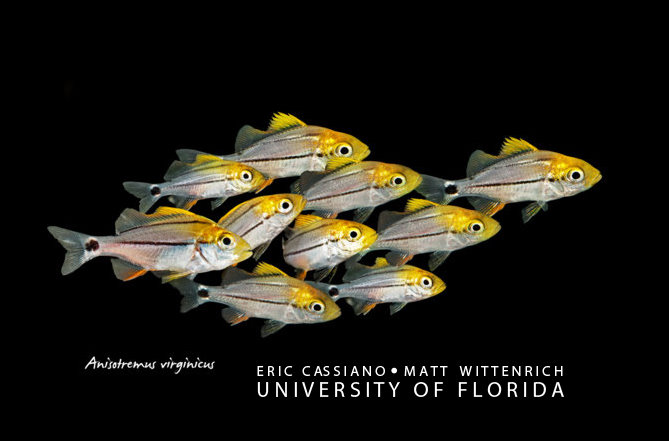The proof is in the results. News broke publicly last week that the University of Florida Tropical Aquaculture Lab has hired well-know marine aquarium author and MASNA 2010 Aquarist of the year Dr. Matthew L. Wittenrich. This organization has been working extensively as part of the Rising Tide Program to encourage marine fish propagation at the institutional level.
Additionally, the Rising Tide efforts have resulted in a couple interesting events, including the successful captive spawning and rearing of the Porkfish, Anisotremus virginicus, whichis a pelagic spawning fish with small eggs that has value both as a foodfish and an ornamental. No matter how you feel about this beautiful Atlantic fish, the techniques applied to its successful transportation, incubation and rearing may prove useful to other species you might also feel strongly about!

Reported anecdotally in the most recent Rising Tide update, Dr. Wittenrich is already proving his value to the team and program. In a recent release announcing Wittenrich’s coming aboard at UofF’s FTA, Rising Tide relayed that they, “received a shipment of sergeant major eggs from SeaWorld San Antonio earlier this week and a significant amount of them had prematurely ruptured from their egg membrane. We put the few remaining, intact ones into our newly renovated larval rearing system and the ruptured ones we were going to dump,” said the update. ”
Matt decided instead to test incubation of these ruptured embryos using Oxolinic acid in the remote chance that they would continue to develop. Of the two age classes examined, older ruptured embyos (~5 days post hatch) survived to ‘hatching’ at a rate of 35-50% survivorship.”
Another arguably groundbreaking report is the successful breeding and rearing of captive-spawned Porkfish, Anisotremus virginicus, from unidentified eggs collected at Sea World in Orlando and transfered to the Florida Tropical Aquaculture Lab. This is not the first time this species has been reared in captivity; Martin Moe reports Aqualife Research Corp. hatching and rearing eggs collected from wild adult Porkfish back in 1978-79 (DESCRIPTION OF PORKFISH LARVAE (ANISOTREMUS VIRGINICUS, HAEMULIDAE) AND THEIR OSTEOLOGICAL DEVELOPMENT Thomas Potthoff, Sharon Kelley, Martin Moe and Forrest Young). Thanks to Anderson for also pointing me to an obscure reference to a presentation called “Presentation of “Breeding and rearing of Anisotremus virginicus” at Aquarium La Rochelle. Still, this is the first time we are aware of that captive-spawned eggs of this species — collected at one facility and transported to another — have been reared successful (at least for this species!). Depending on the techniques applied by Aquarium La Rochelle, this success could also represent only the first or second time that the species has been reared without the use of wild plankton as a diet. No small feat, and a proof of how our marine larviculture methodologies and materials may finally be improving from 40 years ago.

Rising Tide reports that multiple rearing techniques were attempted on two batches of eggs, starting feeding at two days post hatch. The batch that ultimately resulted in over 200 juveniles was initially offered a mixture of wild zooplankton, rotifers, live T-ISO, and nano paste for the first 10 days of feeding (while more successful initially, a mix omitting T-Iso but including copepod nauplii did not result in many juveniles, possibly due to unrelated factors). Both runs were weaned onto Artemia at approximately 10 days post hatch and weaning onto an artificial diet began on approximately day 14 post hatch.
The majority of successfully reared larvae have been visually identified now as porkfish, with a handful of juveniles belonging to another species. “Based on my initial observations, [Porkfish] could be a potential candidate for commercial production. Whether it’s a species that there’s a market for or not is beyond me. We’ll know more after the replicated feeding trials,” wrote Rising Tide’s Eric J. Cassiano. Based on these early successes, Rising Tide is once again putting out the challenge to public aquariums to “send us some eggs.” You can find out more about Rising Tide on their website.



